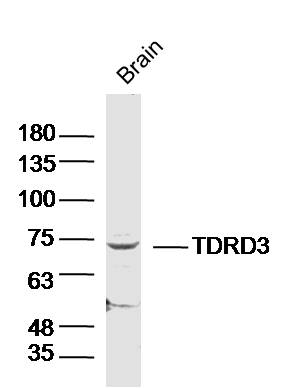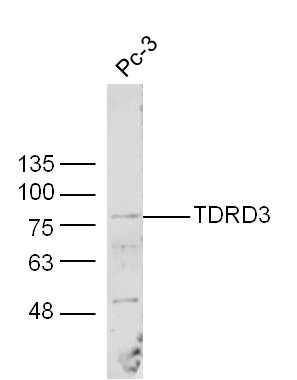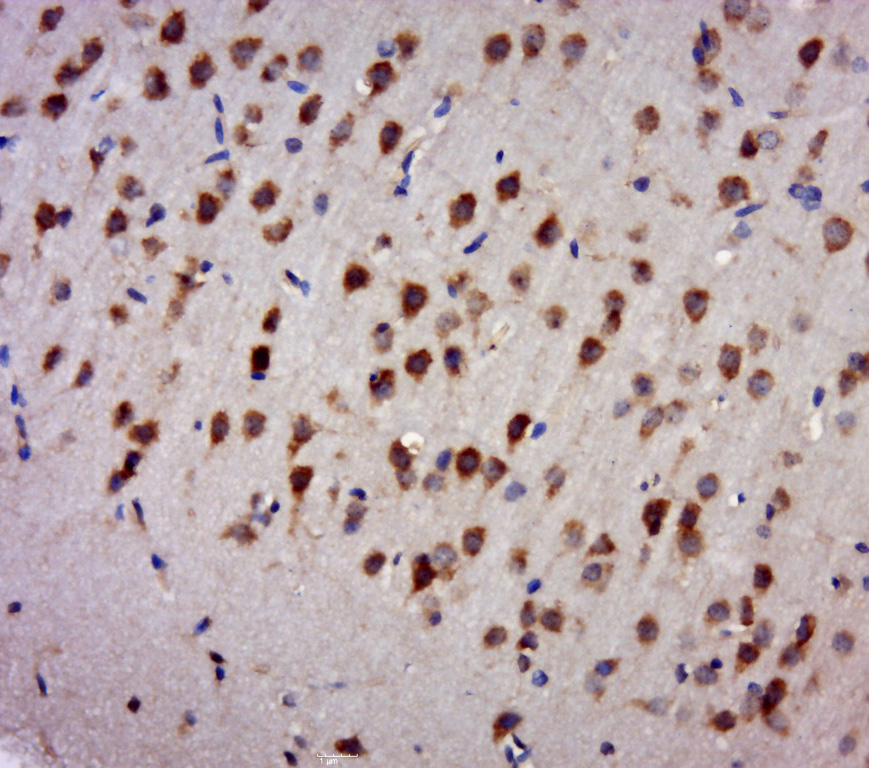
Rabbit Anti-TDRD3 antibody
TDRD 3; tdrd3; TDRD3_HUMAN; Tudor domain containing 3; Tudor domain containing protein 3; Tudor domain-containing protein 3; 4732418C03Rik; 6720468N18; FLJ21007; OTTHUMP00000018485.
View History [Clear]
Details
Product Name TDRD3 Chinese Name Tudor结构域蛋白TDRD3抗体 Alias TDRD 3; tdrd3; TDRD3_HUMAN; Tudor domain containing 3; Tudor domain containing protein 3; Tudor domain-containing protein 3; 4732418C03Rik; 6720468N18; FLJ21007; OTTHUMP00000018485. Research Area Cell biology Neurobiology Epigenetics Immunogen Species Rabbit Clonality Polyclonal React Species Human, Mouse, Rat, (predicted: Chicken, Pig, Horse, Rabbit, ) Applications WB=1:500-2000 ELISA=1:5000-10000 IHC-P=1:100-500 IHC-F=1:100-500 ICC=1:100-500 IF=1:100-500 (Paraffin sections need antigen repair)
not yet tested in other applications.
optimal dilutions/concentrations should be determined by the end user.Theoretical molecular weight 73kDa Cellular localization The nucleus cytoplasmic Form Liquid Concentration 1mg/ml immunogen KLH conjugated synthetic peptide derived from human TDRD3: 161-250/651 Lsotype IgG Purification affinity purified by Protein A Buffer Solution 0.01M TBS(pH7.4) with 1% BSA, 0.03% Proclin300 and 50% Glycerol. Storage Shipped at 4℃. Store at -20 °C for one year. Avoid repeated freeze/thaw cycles. Attention This product as supplied is intended for research use only, not for use in human, therapeutic or diagnostic applications. PubMed PubMed Product Detail Tudor domain containing 3 is a 651 amino acid protein that localizes to both the nucleus and the cytoplasm and contains one UBA domain and one tudor domain. Expressed in lung, brain, heart, liver, placenta, kidney, pancreas and skeletal muscle, TDRD3 exists as a component of mRNA stress granules and is thought to play a role in the translation of target mRNAs, as well as in the assembly and disassembly of stress granules. Multiple isoforms of TDRD3 exist due to alternative splicing events. The gene encoding TDRD3 maps to human chromosome 13, which houses over 400 genes, such as BRCA2 and RB1, and comprises nearly 4% of the human genome. Trisomy 13, also known as Patau syndrome, is deadly and the few who survive past one year suffer from permanent neurologic defects, difficulty eating and vulnerability to serious respiratory infections.
Function:
Scaffolding protein that specifically recognizes and binds dimethylarginine-containing proteins. In nucleus, acts as a coactivator: recognizes and binds asymmetric dimethylation on the core histone tails associated with transcriptional activation (H3R17me2a and H4R3me2a) and recruits proteins at these arginine-methylated loci. In cytoplasm, may play a role in the assembly and/or disassembly of mRNA stress granules and in the regulation of translation of target mRNAs by binding Arg/Gly-rich motifs (GAR) in dimethylarginine-containing proteins.
Subunit:
Component of mRNA stress granules. Interacts with FMR1, FXR1, FXR2, EWSR1, FUS, SERBP1, EEF1A1 and DDX3X or DDX3Y, and with the small nuclear ribonucleoprotein-associated proteins SNRPB and SNRPN. Interacts with 'Lys-48'-linked tetra-ubiquitin, but not with monoubiquitin or 'Lys-63'-linked ubiquitin chains.
Subcellular Location:
Cytoplasm. Nucleus. Predominantly cytoplasmic. Associated with actively translating polyribosomes and with mRNA stress granules.
Tissue Specificity:
Detected in heart, brain, placenta, lung, liver, skeletal muscle, kidney and pancreas.
Similarity:
Contains 1 Tudor domain.
Contains 1 UBA domain.
SWISS:
Q9H7E2
Gene ID:
81550
Database links:Entrez Gene: 418823 Chicken
Entrez Gene: 452750 Chimpanzee
Entrez Gene: 81550 Human
Entrez Gene: 219249 Mouse
Entrez Gene: 431810 Xenopus laevis
Entrez Gene: 395019 Xenopus tropicalis
Omim: 614392 Human
SwissProt: Q5ZMS6 Chicken
SwissProt: Q9H7E2 Human
SwissProt: Q91W18 Mouse
SwissProt: Q6NRP6 Xenopus laevis
SwissProt: Q6P1U3 Xenopus tropicalis
Product Picture
Primary: Anti- TDRD3 (SL11768R) at 1/300 dilution
Secondary: IRDye800CW Goat Anti-Rabbit IgG at 1/20000 dilution
Predicted band size: 73kD
Observed band size: 73kD
Sample:
pc-3 Cell (Human) Lysate at 30 ug
Primary: Anti-TDRD3 (SL11768R) at 1/300 dilution
Secondary: IRDye800CW Goat Anti-Rabbit IgG at 1/20000 dilution
Predicted band size: 73 kD
Observed band size: 77 kD
Paraformaldehyde-fixed, paraffin embedded (rat brain tissue); Antigen retrieval by boiling in sodium citrate buffer (pH6.0) for 15min; Block endogenous peroxidase by 3% hydrogen peroxide for 20 minutes; Blocking buffer (normal goat serum) at 37°C for 30min; Antibody incubation with (TDRD3) Polyclonal Antibody, Unconjugated (SL11768R) at 1:400 overnight at 4°C, followed by a conjugated secondary (sp-0023) for 20 minutes and DAB staining.
Bought notes(bought amounts latest0)
No one bought this product
User Comment(Total0User Comment Num)
- No comment





 +86 571 56623320
+86 571 56623320
 +86 18668110335
+86 18668110335

